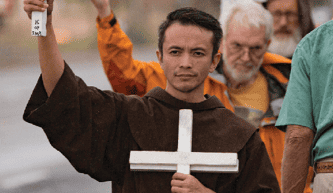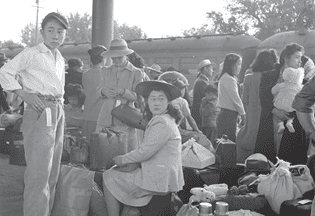Common Ground
Racism From the Inside Out
BY SAM NASADA, OFM

“Oh, your English is so good.”
My face used to beam whenever I heard somebody say that to me. I took it as a sign that I was sounding more like an American, a goal that I had been trying to achieve ever since I came to this country in 1997. Or perhaps it was earlier than that. I had always been fascinated by American TV shows and movies. I remember how my brother and I were crazy about the TV show CHiPs.
I thought those two budding California Highway Patrol officers on motorcycles on the show were the personification of coolness. My mom got us CHiP’s uniforms. I always looked for new police set toys in the store. I wanted to look like them, talk like them, and fight bad guys like they did.
It wasn’t until recently that I was able to see a deeper layer to a seemingly innocent compliment about how good my English was. There has been an ongoing perception in the United States that someone who is of an Asian origin is a foreigner. I admit that since I’m a first-generation immigrant, I sort of fit that label. But I know that Asians who were born in this country sometimes still get asked, “Where are you really from?” It is as if Asians are seen as “perpetual foreigners” in this country.

Photo: Dorothea Lange, Public Domain, via Wikimedia Commons
The mass relocation of United States citizens of Japanese ancestry is a shameful, racist, part of American history People lost shops, homes, and human dignity.
The other phenomenon that is a very common experience for Asian Ameri- cans is what is called the “model minority.” This is a notion that all Asians are smart, hard-working, law-abiding, and docile. It is true that part of this narrative is pushed by some Asian American families, who teach their children to never “rock the boat” as long as they have a successful career, and their family can live comfortably enough.
Unfortunately, as we have learned recently, leading a quiet, comfortable life does not make us immune from racially motivated attacks. Perceiving Asians as meek foreigners makes us easy targets to blame when something bad happens.
This pattern has repeated itself throughout our nation’s history. In 1882, Congress passed the Chinese Exclusion Act out of fear that the Chinese were taking jobs from American citizens. In 1931, a group of white men attacked Filipino farmworkers in Watsonville out of fear that they were taking white women as wives. In 1942, Japanese Americans were interned in camps out of fear that they would collaborate with America’s enemy during World War II. And now it’s happening again, with anti-Asian bigotry surfacing around CO- VID-19. The pandemic started in China, after all (as if that has anything to do with Asian people as a whole). This fact was the fuel for inflammatory rhetoric from the country’s leadership. As a result, the US has seen anti-Asian hate crimes double in the past year.
I find these facts of US history similar to the Chinese-Indonesian experience in my home country. For a long time, we were given a special code on our national identity card that singled us out as ethnic Chinese. When I first applied for my Indonesian passport, there was a law that required me to submit a special letter proving my father’s citizenship.
This law only applied to Indonesian citizens of Chinese descent. Whenever the economy tanked, Chinese-Indonesians were usually first to blame and their businesses were prime targets for looting. In 1997, anti-Chinese riots disintegrated into widespread sexual attacks against Chinese-Indonesian women. Up to this day, the Indonesian government still refuses to acknowledge the full extent of this atrocity.
There is an even more harmful consequence of the model minority myth in America. Ellen D. Wu, a history professor at Indiana University, in her op-ed for the Los Angeles Times gave some examples of how this idea was used to contrast Chinese with African Ameri- cans. In the 1960s, many in US politics, academia, and media upheld Chinese- American culture as a model for African Americans to follow, one that integrated more peaceably into predominantly white America. That highlighting the Asians’ docility was a way to “counter the demands of civil rights and black- power activists for substantive change.”
During my still-limited time ministering as priest, I have had some people express that they were tired of hearing about racism. Some of you reading this article may sympathize with that feeling. I completely understand that our nation has been wrought with racial tensions these past few years. However, it would be a mistake to resolve the racism issue by sweeping everything under the rug and pretending everything is fine and dandy. In that spirit, I offer a few suggestions for moving forward in the accompanying box on the opposite page.
I gave up my dream to be a motorcycle-riding cop on the highways of California like in that ‘80s TV show a long time ago. Instead, I now share the dream of Dr. Martin Luther King Jr. in the ‘60s: that one day all God’s children—black, white, Jew, Gentile, Hispanic, Asian, Pacific Islanders—will be able to join hands together as true brothers and sisters. ❖
Father Sam Nasada, OFM, is associate pastor at Old Mission San Luis Rey.
Credit: The Way of St. Francis SUMMER 2021· VOL.26, NO.2

